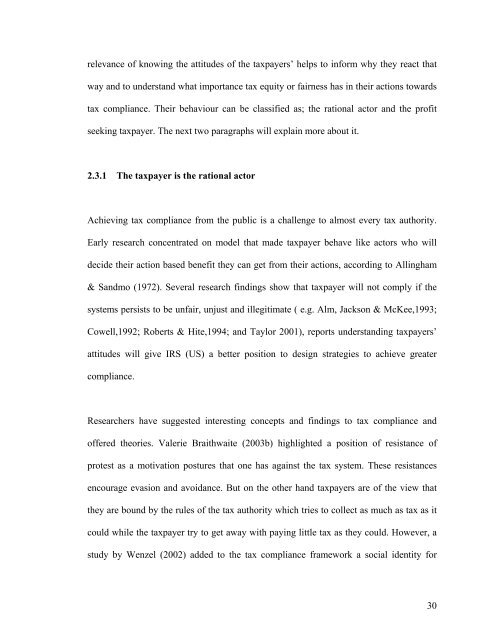1 CHAPTER 1: INTRODUCTION 1.0 Chapter ... - DSpace@UM
1 CHAPTER 1: INTRODUCTION 1.0 Chapter ... - DSpace@UM
1 CHAPTER 1: INTRODUCTION 1.0 Chapter ... - DSpace@UM
Create successful ePaper yourself
Turn your PDF publications into a flip-book with our unique Google optimized e-Paper software.
elevance of knowing the attitudes of the taxpayers’ helps to inform why they react thatway and to understand what importance tax equity or fairness has in their actions towardstax compliance. Their behaviour can be classified as; the rational actor and the profitseeking taxpayer. The next two paragraphs will explain more about it.2.3.1 The taxpayer is the rational actorAchieving tax compliance from the public is a challenge to almost every tax authority.Early research concentrated on model that made taxpayer behave like actors who willdecide their action based benefit they can get from their actions, according to Allingham& Sandmo (1972). Several research findings show that taxpayer will not comply if thesystems persists to be unfair, unjust and illegitimate ( e.g. Alm, Jackson & McKee,1993;Cowell,1992; Roberts & Hite,1994; and Taylor 2001), reports understanding taxpayers’attitudes will give IRS (US) a better position to design strategies to achieve greatercompliance.Researchers have suggested interesting concepts and findings to tax compliance andoffered theories. Valerie Braithwaite (2003b) highlighted a position of resistance ofprotest as a motivation postures that one has against the tax system. These resistancesencourage evasion and avoidance. But on the other hand taxpayers are of the view thatthey are bound by the rules of the tax authority which tries to collect as much as tax as itcould while the taxpayer try to get away with paying little tax as they could. However, astudy by Wenzel (2002) added to the tax compliance framework a social identity for30
















